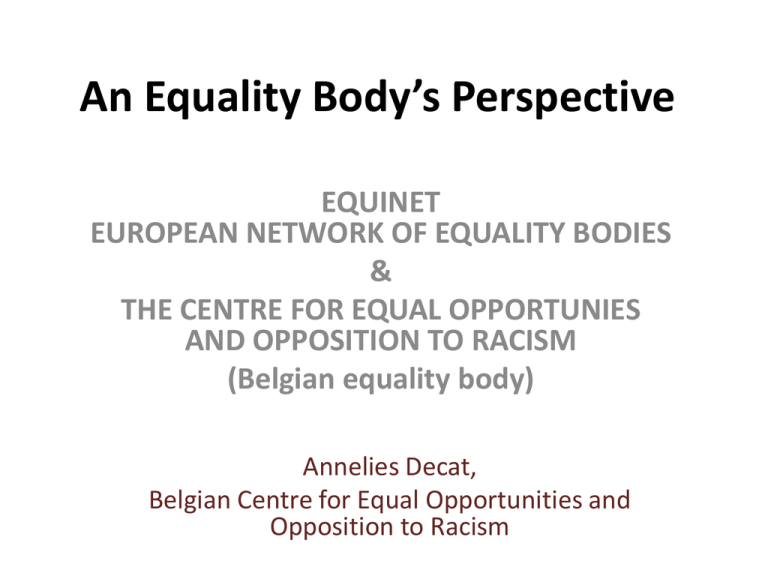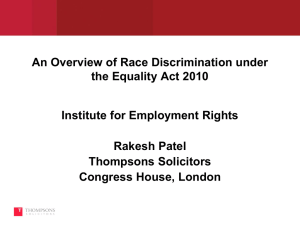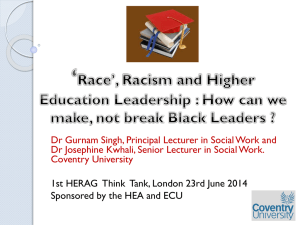
An Equality Body’s Perspective
EQUINET
EUROPEAN NETWORK OF EQUALITY BODIES
&
THE CENTRE FOR EQUAL OPPORTUNIES
AND OPPOSITION TO RACISM
(Belgian equality body)
Annelies Decat,
Belgian Centre for Equal Opportunities and
Opposition to Racism
EQUINET
EUROPEAN NETWORK OF
EQUALITY BODIES
Equinet – the European Network
of Equality Bodies
• Network of specialised equality bodies (38 members
from 31 European countries)
• Specialised equality bodies on the basis of EC Equal
Treatment Directives (2000/43/EC; 2004/113/EC;
2006/54/EC), in line with UN Paris Principles and ECRI
Policy Recommendation on Specialised Bodies
• Diversity among national equality bodies in terms of
size, mandate, grounds, structure and experience
Functions of Equality Bodies
• Functions laid down in EU directives:
– Independent assistance to victims of discrimination
– Independent surveys and reports concerning
discrimination
– Recommendations on discrimination issues
– Exchange of information with European bodies
• Wider functions taken on by Equality Bodies:
awareness raising, promotion of good practices
Equality Bodies working on LGBTI issues (I)
Equinet perspective on ‘Equality Bodies Combating Discrimination against
and Promoting Equality for LGBTI People’
• Context / Operating environment:
– an hostile context (e.g. hate crime and speech) poses dilemmas for
equality bodies: how to improve the context and protect individuals from
retribution
• Under-reporting:
– Few complaints to equality bodies on LGBTI issues. On hate
crime/speech lack of legislation and mandate to equality bodies.
• Tactics:
– cooperation with LGBTI organisations
– ripple effect of casework;
– research and awareness raising.
Equality Bodies working on LGBTI issues (II)
• Internal challenges:
– Different levels of independence and effectiveness of equality
bodies
– Prioritarisation on other foci in case of limited resources
• Diversity of the LGBTI group
– Need attention to differences as gender, multiple discrimination,
appartenance to the LGBTI communities; specificities of trans
and intersex issues.
Conclusions – lessons learnt on how to
enhance the context (I)
• Closing gaps in EU and national legislation to respond
to discriminating experiences of LGBTI people, and
providing mandate to equality bodies for assisting
them (e.g. outside the employment field; hate crime and
speech).
• Strategic framework to advance equality: national
strategies to advance equality for LGBTI people have
proven valuable tools.
Conclusions – lessons learnt on how to
enhance the context (II)
• Public sector duties: statutory duties on public sector institutions to
promote equality.
• Specific focus on trans people and intersex people recognising a
distinct experience of discrimination
• Funding to equality bodies to enable them support their work on
LGBTI people
• Data: close data deficits
• Cooperation between equality bodies to share good practices.
The Centre for Equal
Opportunities and Opposition
against Racism
www.diversite.be
The work of the Belgian Centre
for Equal Opportunities and
Opposition to Racism
• An independent public body
• Founded by law in 1993
• Missions:
1. To promote equal opportunities and to combat
discrimination and exclusion
2. To ensure the basis rights of foreigners + to map
migratory flows
3. To promote the struggle against human trafficking
and smuggling
Tasks:
• Treatment of queries and complaints
about discrimination or the
fundamental rigths of foreigners
• Information and awareness raising
• Opinions and (policy)
recommendations
The Centre in figures
•
•
•
•
•
•
•
•
In 2012, the Centre received a total of 5,118 complaints.
83% discrimination, hate speech and hate crimes; 17% fundamental rights of foreigners.
The 4,226 complaints relating to alleged occurrences of discrimination, hate speech and hate
crimes led to 1,315 case files being opened.
Legal action in 5 cases of discrimination; 46 case files led to negotiated solutions. It also
associated in court action with the public prosecutor in 5 cases of human trafficking and 16
cases of trade in human beings.
Information sessions (< ½ day) to the tune of 293 hours and training sessions (min ½ day) to
the tune of 1,847 hours, reaching 8,207 people.
45 opinions & recommendations: 17 discrimination/equal opportunities, 9 migration, 19
trafficking.
102.51 full-time equivalent employees (FTE).
8 international partnerships: Equinet, FRA, NPC INT, National Contact Point EMN, ECRI,
ODIHR, Informal Network of National Rapporteurs or Equivalent Mechanisms for Combating
Trafficking in Human Beings, UN.
Annual Activity and Management Report
Sexual orientation:
Belgian context
•
•
•
•
•
1996: first Pride in Brussels
1998: civil partnership
2003: same sex mariage
2003: anti discrimination law (1st version)
2004: same sex mariage for Belgians &
foreigners
• 2006: adoption
• 2007: anti discrimination law (2nd version)
LGB work of the Centre:
queries and complaints
LGB Work of the Centre:
information and awareness raising
• Brochures, leaflets, Pride, website, local
workshops, …
• Commissioning research: homophobic attitudes,
violence, education, work floor, alternative
measures,…
• Collaboration with the police: training, brochure,
checklists, circular, …
• Contacts with NGOs
Hate speech:
monitoring cyberhate
• Cyber hate Hotline; launched in 2006 in order to
respond to the rise of racism and xenophobia on
the Internet.
• Awareness raising activities (in schools, on
demand, but also for police and justice) ;
• Advice and recommendations for policy makers,
justice and practitioners.
Cyber Hate Hotline
• The daily work of the hotline has shown that there is a
huge willingness of users to complain about online
hate mongers.
• In 2010 the Centre monitored more than 600
complaints of online hate and discrimination, found by
Internet users or staff on websites, web forums, in
guest books, chat sessions, video clips or music files;
• The Centre reports a huge growth of hate videos on
social network sites, on web logs and in chain mails.
Anti-Semitic expressions and especially hate against
Muslims is on the rise.
Instruments to tackle cyber hate
Three Belgian laws underpin the fight against online hate speech:
– the ANTI-RACISM LAW, or the law of July 30 1981 to punish certain
crimes inspired by racism or xenophobia (amended by the law of May 10
2007);
– the ANTI-DISCRIMINATION LAW, or the law of May 10 2007 for
fighting certain types of discrimination;
forbid persons to ‘incite to’ discrimination, segregation, hatred or violence
against persons or groups of persons based on certain qualities (nationality, socalled ‘race’, skin color…).
Malicious intention of the author is very important in the qualification of the
concept ‘incitment’!
– the LAW AGAINST NEGATIONISM, or the law of March 23 1995 to
punish the denial, minimization, justification or approval of the genocide
committed by the German national socialist regime during the Second
World War
1. Notice and take down
What? Author is informed and motivated
to take action to remove illicit material
Effective? Yes, because:
• The Belgian constitutional system of cascading liability for press
offences makes it possible for internet service providers to be held liable
for racist statements and hate speech on their servers
• Website administrators and owners of forums or blogs are increasingly
often taking the initiative of imposing a code of conduct on their users
(contains provisions about racism and xenophobia)
• Web forums and newsgroups, hate videos on web 2.0 communities and
trans-national neo-Nazi platforms are often hosted abroad so we jump
over national law.
• Refusing to remove could be an indication for malicious intentions
Succesful way of mediation 95% of cases solved!
2. Countering hateful
chain mails
Most complaints concern hateful chain mails
– Sent to us by ‘general’ internet users, by seniors, employers,
users who receive chain mails from friends and family… who
look for counter actions without having to trace the original
author or to action against the ‘mail friend’
– We provide ‘evidenced based analysis’, ‘discourse analysis’,
content analyses and facts and figures
– List of analyses can be consulted on our website
– Strong counter action!
3. Legal action
• In case of …
– requests for removal are not acted upon
– Link with hate crime actions in real life
– Indication of malicious intent to spread hate, violence,
…
• The Centre has in its mission the possibility to file a
complaint with the police or the public prosecutor
• Doing so, we work together with a bailiff (an officer of the
court who is employed to execute writs and processes
and make arrests)
Examples of legal action
- Neo-Nazi groups: currently we have a pending case
about a neo-Nazi group: Bloed-Bodem-Eer en Trouw
(Blood-Earth-Honor-Fidelity)
- Three members of the Belgian Blood and Honour were
convicted for organizing an ss Memorial concert.
internet was used for overall communication to contact
allies all over Europe and to spread practical information
Examples of legal action
Sharia4Belgium: Islam extremist group did an interview on
TV and published it on their website
→interview incites to hatred against homosexuals →
We qualifed the facts as violating anti discrimination law
and transfered a documented and analyzed complaint to
the public prosecutor
Conclusions?
• Mandate
• Network (ex. INACH, Equinet)
• It is a process of trial and error; evolution of
hate speech requires new strategies
• Freedom of expression is crucial, even when
statements are shocking, disturbing or offensive
• Dialogue and debate
• Shared responsibility (counter speech)
Contacts
www.equineteurope.org
Facebook: search and like “Equinet Europe”
Twitter: follow @equineteurope
EQUINET SECRETARIAT
138 Rue Royale / Koningsstraat
B-1000 Brussels, Belgium
Tel: +32 (0)2 212 3182
www.diversite.be
Centre for Equal Opportunities and Opposition
against Racism
Annelies Decat: annelies.decat@cntr.be
138 Rue Royale / Koningsstraat
B-1000 Brussels, Belgium
Tel: +32 (0)2 212 30 00










